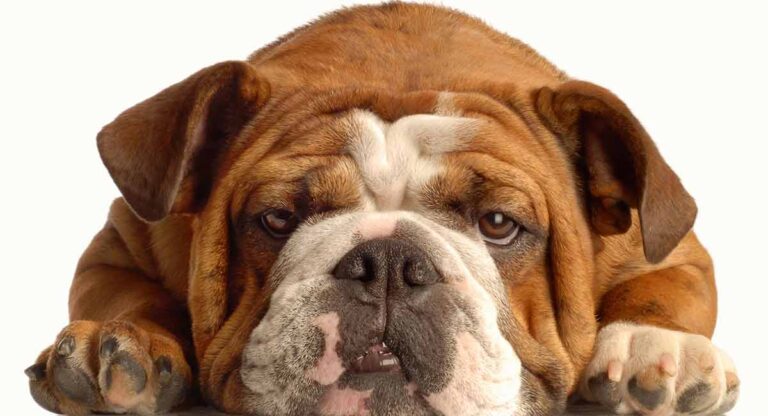Why Do Bulldogs Have Curly Tails?
Bulldogs are known for their distinctive features such as their wrinkled faces, strong jaws, and small ears – but one of the most noticeable characteristics is their curly tails. But where did this special feature come from?
We’ll delve into the past of the bulldog’s curly tail and uncover its fascinating roots.
We’ll also explore how this trait has developed over time and why it remains so integral to the breed today.
What Does It Mean When A Bulldog Curls Its Tail?
Contents
- 1 What Does It Mean When A Bulldog Curls Its Tail?
- 2 Do All Bulldogs Have Corkscrew Tails?
- 3 Why Do Bulldogs Have Curly Tails?
- 4 Are Normally Bulldogs Born With Tails?
- 5 Physical Characteristics of Bulldog Tails
- 6 Common Tail Related Problems in Bulldogs
- 7 Grooming Tips for Keeping Your Bulldog’s Tail Healthy
- 8 Treatment Options for Tail-Related Injuries in Bulldogs
- 9 Conclusion
Have you ever seen your bulldog curl its tail and wondered what it meant? This behavior is a sign of contentment and joy, known as “cork-screwing”. When they curl their tails up, it’s a sign that they are relaxed and comfortable.
Curling their tail can also indicate submission or surrender to another animal or person. If your pup is feeling overwhelmed by its environment, it may curl its tail as a way to protect itself from potential danger.
It may also be a sign that the bulldog is trying to communicate with other animals or people. For example, if two dogs are playing together and one dog curls its tail, this could be an indication that it wants to play more or initiate playtime with the other dog.
Finally, some bulldogs may curl their tails when they are excited about something or want attention from their owners.
If you see your pup’s tail curling in anticipation of getting some affection, don’t hesitate to give them all the cuddles and scratches they deserve.
Do All Bulldogs Have Corkscrew Tails?
It is an inherited characteristic that usually appears in puppies from birth and has become part of the breed standard for many kennel clubs.
The corkscrew tail can range in size and shape, but it typically has a short, thick base with a tight curl at the end.
This curl can be very pronounced or barely visible depending on the individual dog.
So, while not all Bulldogs have corkscrew tails, it’s an interesting feature that many of them possess!
Why Do Bulldogs Have Curly Tails?
It’s a genetic mutation that causes their tails to curl up into a tight spiral shape.
This mutation is believed to have originated in England and has since spread throughout the world with the breed.
The exact cause of this mutation is still unknown, but it is thought to be related to the Bulldogs’ size and weight, as well as physical characteristics such as their short legs and body shape.
Not only does this curled tail give Bulldogs a unique appearance, but it also gives them an advantage when it comes to swimming.
With their curled tail, they can more easily maneuver through the water.
So if you ever see a Bulldog swimming with its curly tail bobbing up and down, you’ll know why.
Bulldogs are loved for many reasons, but their curled tails make them even more special. They are truly one-of-a-kind dogs with a rich history behind them.
Are Normally Bulldogs Born With Tails?
Are Bulldogs born with tails? The answer is yes! Most Bulldogs are born with tails, but some breeds have been selectively bred to have their tails docked. This practice is controversial as it can cause pain and distress to the puppy.
The American Kennel Club (AKC) does not condone or recognize the practice of tail docking, but it does allow for some breeds to be shown with docked tails if they were born with them already docked.
Bulldogs typically have short, straight tails that don’t curl around their body like other breeds such as pugs or corgis.
However, some Bulldogs may have a slight curl at the end of their tail due to genetics or breeding practices, which can give them an even cuter appearance.
So, whatever your preference may be, you should be able to find a Bulldog with the perfect tail for you.
Physical Characteristics of Bulldog Tails
Bulldogs are known for their distinctive physical characteristics, including their tails.
Bulldog tails can range from short and straight to long and curly, and may even have a kink or bend in the middle.
But there’s also the rare corkscrew tail, which is an abnormality that causes the tail to curl up at the end.
Unfortunately, Bulldogs can also be prone to tail-related problems such as malformation, tumors, and infections.
If you notice any changes in your Bulldog’s tail, it’s important to keep an eye on it and visit your veterinarian if necessary.
Common Tail Related Problems in Bulldogs
It is important to be aware of the common tail-related problems they may experience.
Bulldogs are prone to a wide range of issues, such as injuries, infections, and diseases that can affect their tail.
Trauma can lead to tail injuries, while poor hygiene or surgery can cause infections.
Luxating patellas, hip dysplasia, and disc disease are just some of the diseases that can cause pain in the tail area and reduce mobility.
If your Bulldog is suffering from any of these disorders, it is important to seek treatment as soon as possible.
Medications, physical therapy, or even surgery may be necessary depending on the severity of the condition.
With proper care and treatment, your Bulldog should be able to live a happy and healthy life free from any tail-related ailments.
Grooming Tips for Keeping Your Bulldog’s Tail Healthy
Grooming your bulldog’s tail is an important part of keeping them healthy and happy. Here are some tips to ensure that your bulldog’s tail stays in good condition.
Start by brushing the tail regularly with a soft bristle brush to remove any dirt or debris. Additionally, make sure to keep the fur around the tail clean and free of mats or tangles.
Check your bulldog’s tail for signs of irritation, redness, or infection regularly. If you notice any unusual lumps or bumps, contact your veterinarian right away.
It is also important to wash your bulldog’s tail with gentle shampoo and warm water every so often. This will help keep the fur clean and healthy. You can also trim the fur around the base of the tail if it gets too long using scissors or clippers.
Treatment Options for Tail-Related Injuries in Bulldogs
Tail-related injuries in Bulldogs can be a painful and difficult experience for both the dog and their owners.
Thankfully, there are several treatment options available depending on the severity of the injury.
Surgery may be necessary for more severe injuries, while rest and physical therapy may be recommended for less serious cases.
Medication can also help reduce inflammation and pain. In some cases, a splint or brace may be used to support the tail as it heals.
It’s important to keep an eye on your Bulldog’s progress after any treatment is given, as adjustments or changes may need to be made if they’re not working as expected.
If you have any questions or concerns about your Bulldog’s injury, it’s best to consult your veterinarian for advice and assistance.
Also Read: Do French Bulldogs Have Tails?
Conclusion
Bulldogs have curly tails for a variety of reasons. The most common reason is that it is a breed trait that has been passed down through generations of bulldogs.
It is believed that the breeders of old wanted to give the Bulldogs a certain look, so they bred them with curled tails.
This trait has been passed down through the generations and is now a defining feature of the breed.
Additionally, some believe that the curled tail helps to protect the bulldog’s spine from injury, as it gives the dog extra support when running and jumping.
Finally, the curled tail is also believed to be an expression of joy, as when a bulldog wags its tail it curls up in a circle.
All in all, the curly tail of a bulldog is an integral part of its breed and serves multiple purposes.




